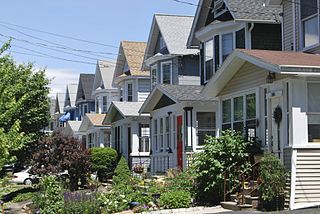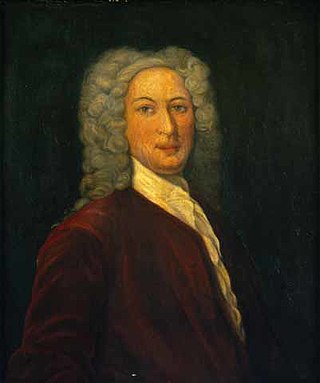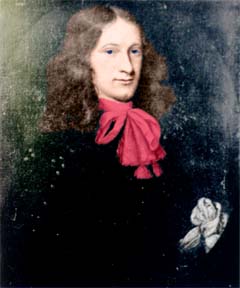
Albany is the capital and oldest city in the U.S. state of New York, and the seat of and most populous city in Albany County. It is located on the west bank of the Hudson River, about 10 miles (16 km) south of its confluence with the Mohawk River.

Robert Livingston the Elder was a Scottish-born merchant and government official in the Province of New York. He was granted a patent to 160,000 acres of land along the Hudson River, becoming the first lord of Livingston Manor.

Thomas Dongan, 2nd Earl of Limerick, was a member of the Irish Parliament, Royalist military officer during the English Civil War, and Governor of the Province of New York. He is noted for having called the first representative legislature in New York, and for granting the province's Charter of Liberties. His negotiations and subsequent alliance with the Iroquois Indian Confederacy brought a lasting security from the French and their hostile Indian allies.

Philip Livingston was an American merchant, slave trader and politician in colonial New York. The son of Robert Livingston the Elder and elder brother of Robert of Clermont, Philip was the second lord of Livingston Manor.

Pieter Schuyler was the first mayor of Albany, New York. A long-serving member of the executive council of the Province of New York, he acted as governor of the Province of New York on three occasions – twice for brief periods in 1709, after the death of Lord Lovelace, and also from 1719 to 1720, after Robert Hunter left office.
The history of Albany, New York, began long before the first interaction of Europeans with the native Indian tribes, as they had long inhabited the area. The area was originally inhabited by an Algonquian Indian tribe, the Mohicans, as well as the Iroquois, five nations of whom the easternmost, the Mohawk, had the closest relations with traders and settlers in Albany.

Thomas Michael Whalen III, also known as Tom Whalen, was an American attorney and politician, and a three-term mayor of Albany, New York, serving from 1983 to 1993. A native of Albany, he graduated from Manhattan College and Albany Law School.
The New York Court of Common Pleas was a state court in New York. Established in the Province of New York in 1686, the Court remained in existence in the Province and, after the American Revolution, in the U.S. state of New York until it was abolished in 1894.

Arbor Hill is a neighborhood in Albany, New York, generally defined as the area from Clinton Avenue north to Tivoli Hollow and the Livingston Avenue Railroad Bridge and from Broadway west to Henry Johnson Boulevard. Both Clinton Avenue and Henry Johnson Boulevard are signed as U.S. Route 9. It was outside Albany's first boundaries as set up in the Dongan Charter of 1686. The original name of the area was Colonie, and the area was incorporated under that name as a village in 1804; it was annexed by Albany in 1815. There are two sub-neighborhoods in Arbor Hill, Dudley Heights and the Ten Broeck Triangle. "Arbor Hill" was the name given to the Ten Broeck estate; the Ten Broeck Mansion is still an important cultural and historical museum. The neighborhood has other historical and cultural sights such as the Palace Theatre and St. Joseph's Church. Demographically it is predominantly African-American.
Nicholas Bayard was a government official and slave trader in colonial New York. Bayard served as the mayor of New York City from 1685 to 1686. He is historically most notable for being Peter Stuyvesant's nephew and for being a prominent member of the Bayard family, which remained prominent in New York City history into the 20th century.

The coat of arms of Albany, New York, is the heraldic symbol representing the city of Albany, the capital of the U.S. state of New York. The coat of arms is rarely seen by itself; it is almost always used in the city seal or on the city flag. The current coat of arms was adopted in 1789, although prior to that it was significantly simpler, ranging from stylized lettering to a caricature of a beaver. Included in the coat of arms are references to Albany's agricultural and fur-trading past. It is supported by a white man and an American Indian and is crested by a sloop. The coat of arms is meant to represent the "symbols of industry and its rewards to man and beast on land and sea".
The history of Albany, New York from 1664 to 1784 begins with the English takeover of New Netherland and ends with the ratification of the Treaty of Paris by the Congress of the Confederation in 1784, ending the Revolutionary War.
The history of Albany, New York from 1983 to present begins with the death of Erastus Corning 2nd, Albany's longest serving mayor. When Corning died in 1983, Thomas Whalen assumed the mayorship and was reelected twice. Albany saw a significant influx of federal dollars earmarked for restoring historic structures. What Corning had saved from destruction, Whalen refurbished. The Mayor's Office of Special Events was created in an effort to increase the number of festivals and artistic events in the city, including a year-long Dongan Charter tricentennial celebration in 1986. Whalen is credited for an "unparalleled cycle of commercial investment and development" in Albany due to his "aggressive business development programs".

Tricentennial Park is an urban park in Albany, New York built to commemorate that city's three hundredth anniversary as an incorporated city and is the site of several statues and monuments. The park encompasses the entire block bounded by Broadway to the east, Columbia Street to the north, James Street to the west, and Steuben Street to the south. First proposed in 1914 it was built in 1986 as part of the tricentennial celebrations of Albany's incorporation as a city in association with the renovation of the Albany Union Station.

Wilhelmus Hendricksen Beekman – also known as William Beekman and Willem Beekman – was a Dutch immigrant to America who came to New Amsterdam from the Netherlands in the same vessel with Director-General and later Governor Peter Stuyvesant.
Dirck Wesselse Ten Broeck, also known as Dirck Wessels, was a prominent early settler of Albany, New York. He is known as "the progenitor of the Albany family of Ten Broecks."

The Albany Charter half dollar, also known as the Albany-Dongan half dollar or Albany half dollar, is a commemorative half dollar struck by the United States Bureau of the Mint in 1936. It was designed by sculptor Gertrude K. Lathrop, who lived in Albany, New York's state capital.

The General Assembly of New York, commonly known internationally as the New York General Assembly, and domestically simply as General Assembly, was the supreme legislative body of the Province of New York during its period of proprietal colonialship and the legislative body of the Province during its period as a crown colony. It was the representative governing body in New York until April 3, 1775, when the Assembly disbanded after the outbreak of the Revolutionary War.

New York City was divided into wards between 1683 and 1938. These were used for the election of various municipal offices, and would later be used to construct the boundaries of larger electoral districts. Prior to the formation of the so-called City of Greater New York in 1898, what is now New York City comprised multiple municipalities that had different histories with wards.















